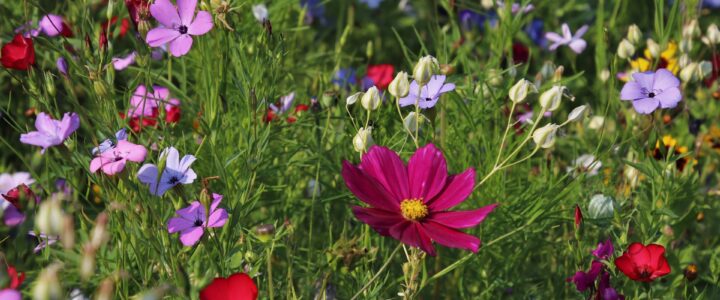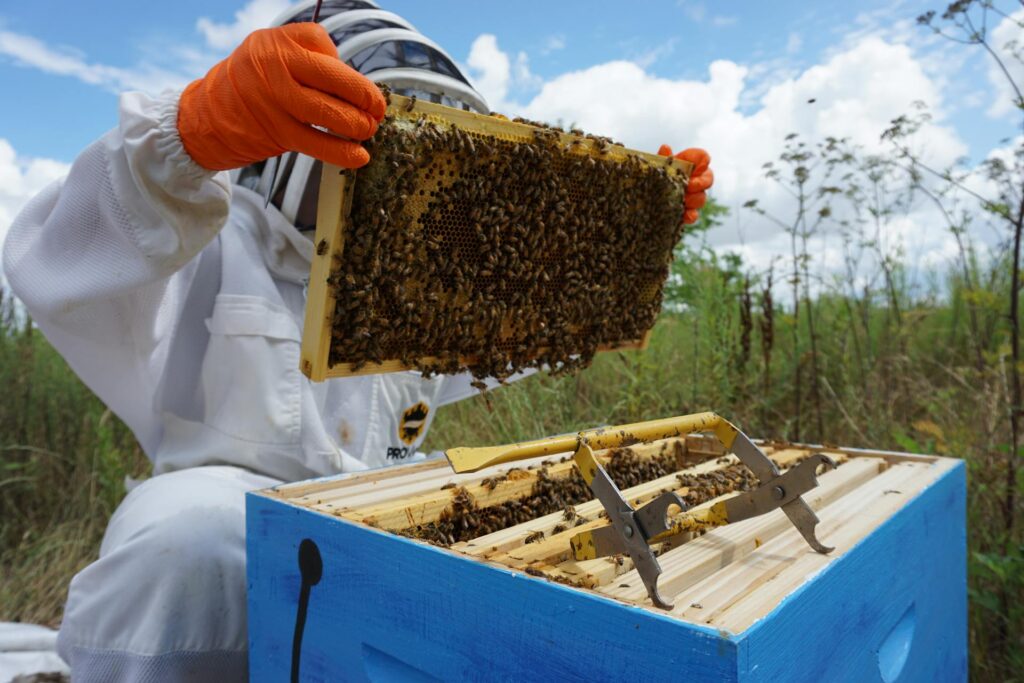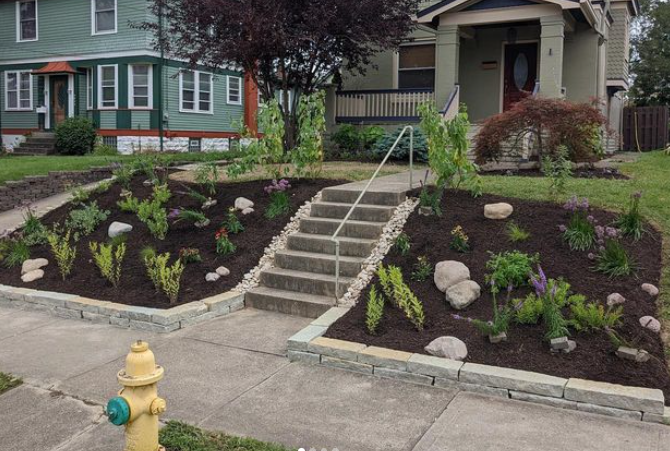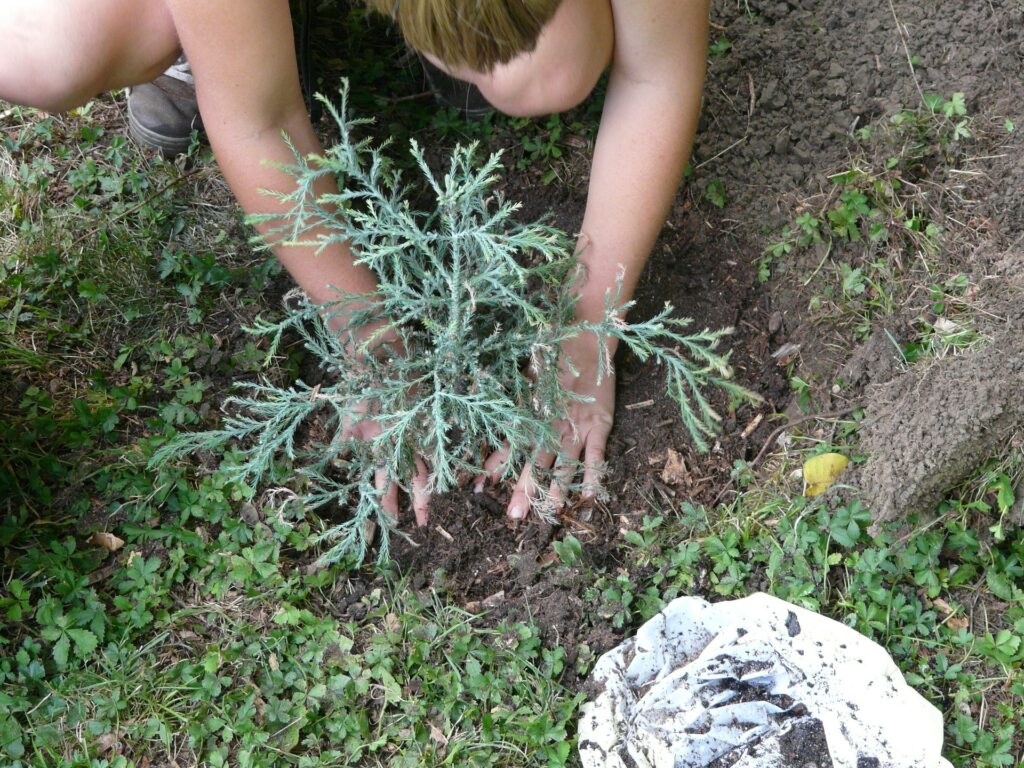
In the bustling city of Cincinnati, developments are built, concrete is poured, and acres are used. But something is missing; people have lost their connection to the land they live on; alongside this, animal and bug species are losing their homes and sustenance needed to survive. Brandon Reynolds, a beekeeper and pollinator habitat landscaper, has been hard at work. Through his work, Reynolds has been able to beautify the city and boost native biodiversity, as well as plant for the future.
Origin Story
Reynolds’ journey began at the University of Cincinnati’s School of Business, where he enrolled in a program called Honors Plus, studying for a semester and working the next until he graduated.
“I was on track to be some sort of sales guy at a company because that’s the only skill I really had. I wasn’t good at finance, accounting, or business analytics,” says Reynolds.
But what he lacked in business administration, he excelled in sales; he says, “…when it came to selling stuff, I could (sell) something I cared about.”
Once he graduated, Reynolds pursued work at an advertising company where he focused on food waste management. “I was trying to learn how to market a food waste recovery app, but I realized that waste recovery, while important to me, is not necessarily going to be financially lucrative,” Reynolds says.
So, Reynolds put that on the back burner and worked on more profitable adverts for heart surgery and internet companies. Still, this work was hardly fulfilling, “…I would go back home and see the Amazon rainforest on fire and polar ice caps melting, and it’s weird because I was marketing something that you may not need,” says Reynolds.
He became disillusioned with his work and started to question his purpose; he says, “Surgery is important, but if the world implodes and we experience global food insecurity or sea levels rise and everybody in Boston has to move to Ohio, we’re going to have a worse time.”
These global events influenced Reynolds, “…there are these big, long-term things that are coming that we don’t understand the importance of because they’re so far away,” he says, and because of what he was seeing, Reynolds decided to resign.
He had finally found his calling: sustainability and environmental protection.

Reynolds started apprenticing at a farm and doing beekeeping, and the following year, he began his pollinator landscaping company.
Looking back at the experience, Reynolds says, “With the apprenticeship and landscaping, I found out that there are hundreds of species that pollinate, not just honeybees. There are moths, birds, butterflies, and even turkeys.”
As his understanding of his environment grew, so did his passion; Reynolds says, “…from there, I morphed into my current business, B the Keeper, where we do landscaping that not only takes into account the honeybees that I worked with before, but also other pollinator species in this network of biodiversity.”
Since 2019, Bradon has been dubbed B the Keeper, building spaces that support the Ohio River Valley and all the life within it. Reynolds still taps into his advertising roots; he says, “…the same way we put up billboards or ads on websites, the landscaping is kind of like an ad.
Everyone who sees it will get some sort of implant of, ‘Oh, that’s what’s possible, sustainability is possible.’ Every day, people experience the work Reynolds has done and the benefits it brings, planting a green seed in the minds of countless people.
Day-to-Day
As summer approaches each year, Reynolds’ operation is a flurry of marketing, client outreach, and planning.
One of Reynolds’ most critical aspects of the business is keeping energy high; he has to keep people interested because he cannot do installations in the winter months.
Whether through interviews, social media posts, or project planning, maintaining interested people is vital. Reynolds describes his typical day as “Marketing, prep, installation, and community connections…” all necessary for growing the business and promoting sustainability.
Across State Lines
Being situated in Cincinnati allows Reynolds to operate in Ohio, Indiana, and Kentucky, and with each in the Ohio River Valley, Reynolds says, “(Our work) largely remains the same because we’re in the same habitat zone.”
There are considerations to be had, though; Reynolds tells me, “There are microclimates; even in one part of Cincinnati, there are plants that will only grow there, so you have to think hyper-locally.”
Each installation is unique, and Reynolds must keep pollinator species and plants in mind as well; one installation may call for daisies, while another may call for daffodils.
The most significant difference Reynolds sees between projects is based on soil quality; he says, “A lot of new houses scalp the topsoil, build the house, then roll grass on top; that topsoil that had been there for hundreds of years is now gone, so you have to start fresh.” According to the Noble Research Institute, America’s largest nonprofit agricultural research organization, signs of healthy soil include dark coloration, the ability to hold its shape, and signs of biological activity.
Sometimes, the soil quality is so poor that his team must bring organic material to offset what was taken. Naturally this process takes thousands of years, but with the right tools and resources, soil can be made viable again in a short time. In the older homes that still have their topsoil, Reynolds says, “The plants feel at home there.”
Horticulture
Horticulture is the science and art of the development, sustainable production, marketing, and use of high-value, intensively cultivated food and ornamental plants; anything you can plant is a part of horticulture, according to Michigan State University.
Reynolds says that horticulture fits “…all the way” with B the Keeper; pollinator species and gardening go hand in hand.
Reynolds says, “…horticulture is the foundation for all the work we do because for us to enjoy honey, for example, honey comes from plants, and if you don’t have any plants, the bees aren’t going to produce any honey… and that’s just for one thing they pollinate, but plants really are the backbone of ecology.”
Everything Reynolds does is directly tied to the relationship between pollinator species and the plants they interact with; ensuring that those relationships are sustainably maintained is crucial.

Biodiversity
The American Museum of Natural History refers to biodiversity as “…the variety of life of life on Earth at all its levels, from genes to ecosystems,” biodiversity is necessary to support all life on Earth; for example, if all animals on Earth shared similar genes, a single disease could sweep through a community and wipe them out. Biodiversity allows for differing genes and uniqueness between all creatures, making them more suited for their environment.
However, the United States is suffering from a severe decline in biodiversity, whether from disease, loss of habitat, or habitat degradation. According to the National Wildlife Federation, America’s largest conservation organization, about a third of all U.S. species are at risk of extinction. “I think biodiversity is key, especially for landscaping, because we love things that look aesthetically pleasing, but we’re not as connected to the environment as we used to, so we weren’t necessarily taught the benefits of having a functional landscape that we draw from,” Reynolds tells me.
People have lost what once connected them to the environment that surrounds them, and for Reynolds, finding that bridge between the visually pleasing and sustainable is significant; he says, “… it’s about pitching the functional and the aesthetically pleasing and marrying them for the humans so that you have a yard that looks great, but you’re also adding to biodiversity by having functional plants that interact with the rest of your yard and the wildlife.”
For Reynolds, keeping the energy chain flowing in his local environment is necessary.
Community Collaboration
Reynolds is not a one-man army; he has worked with schools, companies, and everyday people to build a greener habitat.
Last year, for example, Reynolds received a $20,000 grant from the Duke Energy Foundation. He used that money to hire landscapers and purchase machinery and plants. He also recruited about 30 people from two power companies to volunteer and an additional 30 high school students.
Reynolds says, “…for three consecutive days, we ripped out invasive honeysuckle and replaced it with native woodland shrubs; that was a way for us to utilize the community to reduce cost and expand the scale of the project,” outreach and community connections help to push the green cause even further.
Reynolds and his group were able to teach those students while also connecting them to their environment, once again planting a seed of sustainability in the community’s minds.
The link to the grant rewarded by the Duke Energy Foundation can be found here.
Obstacles
It hasn’t all been smooth riding; Reynolds’ biggest challenge is convincing people to switch to sustainable yards.
Reynolds says that most people are used to paying very little for their landscaping, and when they must pay a bit more to get the results, Reynolds must explain that the point of landscaping is to make an enjoyable yard with little maintenance. Before modern lawns, yards were natural and largely unkempt, with native plant species covering the ground. But since the mid-nineteenth century, Americans have seen well-kept lawns as markers of success since the mid-nineteenth century, with the practice still going strong today, according to the Scientific American.
He says, “It’s about getting people to think about their landscaping as an investment instead of a to-do list; it could produce a bountiful harvest for you and your family for decades to come.”
Harkening back to his sales roots, Reynolds doesn’t call this process a struggle. Instead, he describes it as a game of changing minds and creating growth opportunities.

Spreading the Good Word
One of the most significant challenges sustainability and green practices face is publicity. Too often, it has been swept under the rug in place of traditional practices.
Reynolds’ biggest strategy is to “…talk to as many people as possible while not going insane. You must change your mindset to get real people to think realistically about real places.”
He uses the example of having a flower garden and an apple tree. With the flowers, you can have your six-year-old collect them and sell them as wedding bouquets, and with the apples, you can sell cider and use the husk as compost to further increase your yield on both.
Both are possible by expanding an understanding of your land and what it can do for you. Reynolds says, “What about your land can you touch, taste, smell, feel, and hear, and what does that do to your brain?”
To think about your environment as something that can give is to have a sustainable mindset.
A Changing World
With the constant threat of climate change, Reynolds must adapt and create solutions to previously never-thought-of problems.

He says, “I can see the decimation of habitat when a new development goes in, or a farm does monocropping, and I think about what used to be there… I think about all the possibilities those spaces once had.”
But this doesn’t discourage him; Reynolds says, “… that’s something I can directly change; if I can get 30 people in a neighborhood and one year to plant for the future, then I know I’ve done my part, and I can see it tangibly every day.”
To combat climate change, Reynolds looks to the future; to create change is to make it last for generations to come; he says, “That’s my way of dealing with the climate crisis; we have to do things that are actually tangible.”
Advocacy and Activism
Sustainability and activism go hand in hand; a green future is possible with people who promote environmentalism.
For Reynolds, it’s part of his everyday work; he says, “We’re giving people options to expand their life while also teaching them how to be empathetic, which is the ultimate act of activism.”
With today’s cultural climate being so divided, stepping back and understanding each other and other creatures is essential. Reynolds tells me, “I want people to think outside of their bubble and think about the other side; beekeeping has taught me empathy for another species, and being empathetic allows us to be focused less on taking and more on giving back.”
That’s what sustainability is: giving back to the planet that provides us with everything we have. As humans, we are the deciding factor in the Earth’s health, and if we want to keep it alive, we must give back.
Pay attention to your environment
A simple message from Brandon, aka B the Keeper
Words to Inspire
What can we do to make a change? Reynolds says it’s simple, “Pay attention to your environment.”
Focusing on the problems you and your community face is the first step; the next step is solving them.
Reynolds says, “You must be honest with yourself, fully express yourself, and fully investigate and understand the problems you want to solve in your own unique way. I see this with plants, I see it with bees, everybody’s different, and for you to tap into your uniqueness and find creative ways to express yourself for the good of all humanity and all living things is amazing.”
Creativity and earnestness are essential for developing real solutions for real problems; the final piece of advice Reynolds has is to “…explore yourself and don’t feel discouraged. Double down on your uniqueness to produce things that help all the living things around you. Be altruistic.”
As the world grapples with climate change and ecological degradation, B the Keeper serves as a helping hand to sustainability and a green future. With each project, B the Keeper bridges the gap between the aesthetically pleasing and the functional, planting seeds of environmentalism and adoration for the natural world.


